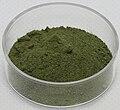Uranium (IV) chloride
| Crystal structure | ||||||||||||||||
|---|---|---|---|---|---|---|---|---|---|---|---|---|---|---|---|---|

|
||||||||||||||||
| __ U 4+ __ Cl - | ||||||||||||||||
| Crystal system | ||||||||||||||||
| Space group |
I 4 1 / amd (No. 141) |
|||||||||||||||
| Lattice parameters |
a = 829.6 pm |
|||||||||||||||
| General | ||||||||||||||||
| Surname | Uranium (IV) chloride | |||||||||||||||
| other names |
Uranium tetrachloride |
|||||||||||||||
| Ratio formula | UCl 4 | |||||||||||||||
| Brief description |
green octahedral crystals |
|||||||||||||||
| External identifiers / databases | ||||||||||||||||
|
||||||||||||||||
| properties | ||||||||||||||||
| Molar mass | 379.84 g mol −1 | |||||||||||||||
| Physical state |
firmly |
|||||||||||||||
| density |
4.72 g cm −3 |
|||||||||||||||
| Melting point |
590 ° C |
|||||||||||||||
| boiling point |
791 ° C |
|||||||||||||||
| solubility |
|
|||||||||||||||
| Hazard and safety information | ||||||||||||||||
 Radioactive |
||||||||||||||||
|
||||||||||||||||
| As far as possible and customary, SI units are used. Unless otherwise noted, the data given apply to standard conditions . | ||||||||||||||||
Uranium (IV) chloride is a chemical compound made up of the elements uranium and chlorine . It has the formula UCl 4 and belongs to the chloride class .
presentation
Uranium (IV) chloride is produced in large quantities by reacting carbon tetrachloride with uranium dioxide (UO 2 ) at 370 ° C.
It is also possible to show it by reacting uranium dioxide with thionyl chloride , whereby the uranium (IV) chloride that is formed always contains some sulfur,
or the reaction of uranium (III) chloride with chlorine,
or the reaction of uranium trioxide with hexachloropropene ,
or the reaction of uranium dioxide with carbon and chlorine, the reaction producing an extremely pure uranium (IV) chloride.
Uranium metal was first isolated in 1841 by Eugène-Melchior Péligot by reducing uranium (IV) chloride with potassium .
properties
It is a dark green, finely divided light green or olive green, radioactive powder. It can be sublimed to red-brown vapor in a dry nitrogen or argon stream at around 600 ° C. Uranium tetrachloride resublimed from this forms deep green crystals with a metallic surface shimmer. It is soluble in water, methanol , ethanol , acetone , pyridine , ethyl acetate , but insoluble in phosphorus trichloride , thionyl chloride, phosphorus oxychloride and liquid chlorine. The compound has a tetragonal crystal structure with the space group I 4 1 / amd (space group no. 141) with the lattice parameters a = 829.6 pm and c = 748.7 pm.
use
Uranium (IV) chloride is used as a starting material in electromagnetic isotope separation (EMIS) in uranium enrichment ; the alpha calutron developed by Ernest O. Lawrence was used for this . In 1944, the Y-12 National Security Complex began to produce UCl 4 from UO 3 in order to have the starting material. The advantage of uranium (IV) chloride is that it is less corrosive than uranium hexafluoride .
Individual evidence
- ↑ a b c d R. CL Mooney: “The Crystal Structure of ThCl 4 and UCl 4 ”, in: Acta Crystallographica , 1949 , 2 , pp. 189-191 ( doi: 10.1107 / S0365110X49000485 ).
- ↑ a b c d David R. Lide (Ed.): CRC Handbook of Chemistry and Physics . 90th edition. (Internet version: 2010), CRC Press / Taylor and Francis, Boca Raton, FL, Properties of the Elements and Inorganic Compounds, pp. 4-97.
- ↑ a b c d e f g Georg Brauer (Hrsg.): Handbook of Preparative Inorganic Chemistry . 3., reworked. Edition. tape II . Enke, Stuttgart 1978, ISBN 3-432-87813-3 , p. 1210 .
- ↑ Entry on uranium compounds in the GESTIS substance database of the IFA , accessed on February 1, 2016 (JavaScript required)
- ↑ Not explicitly listed in Regulation (EC) No. 1272/2008 (CLP) , but with the specified labeling it falls under the group entry uranium compounds with the exception of those specified elsewhere in this Annex in the Classification and Labeling Inventory of the European Chemicals Agency (ECHA) , accessed on February 1, 2016. Manufacturers or distributors can expand the harmonized classification and labeling .
- ↑ The hazards emanating from radioactivity do not belong to the properties to be classified according to the GHS labeling.
literature
- Ingmar Grenthe, Janusz Drożdżynński, Takeo Fujino, Edgar C. Buck, Thomas E. Albrecht-Schmitt, Stephen F. Wolf: Uranium , in: Lester R. Morss, Norman M. Edelstein, Jean Fuger (eds.): The Chemistry of the Actinide and Transactinide Elements , Springer, Dordrecht 2006; ISBN 1-4020-3555-1 , pp. 253-698 ( doi : 10.1007 / 1-4020-3598-5_5 ).
- Donald R. Olander, JL Camahort: "Reaction of Chlorine and Uranium Tetrachloride in the Fused Lithium Chloride-Potassium Chloride Eutectic", in: AIChE Journal , 1966 , 12 (4), pp. 693-699 ( doi: 10.1002 / aic. 690120414 ).
- JC Taylor, PW Wilson: “A Neutron Diffraction Study of Anhydrous Uranium Tetrachloride”, in: Acta Cryst. , 1973 , B29 , pp. 1942-1944 ( doi: 10.1107 / S0567740873005790 ).









